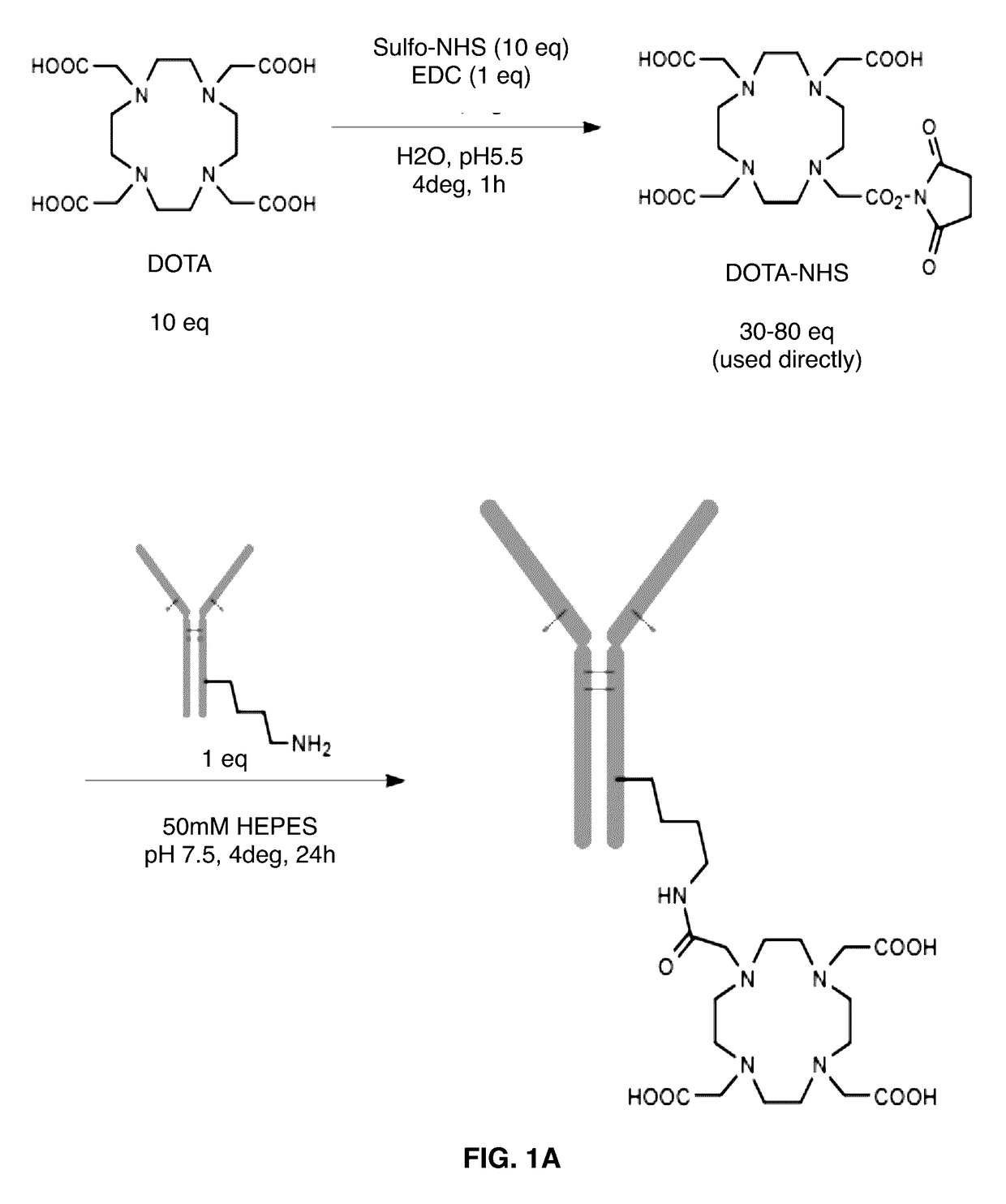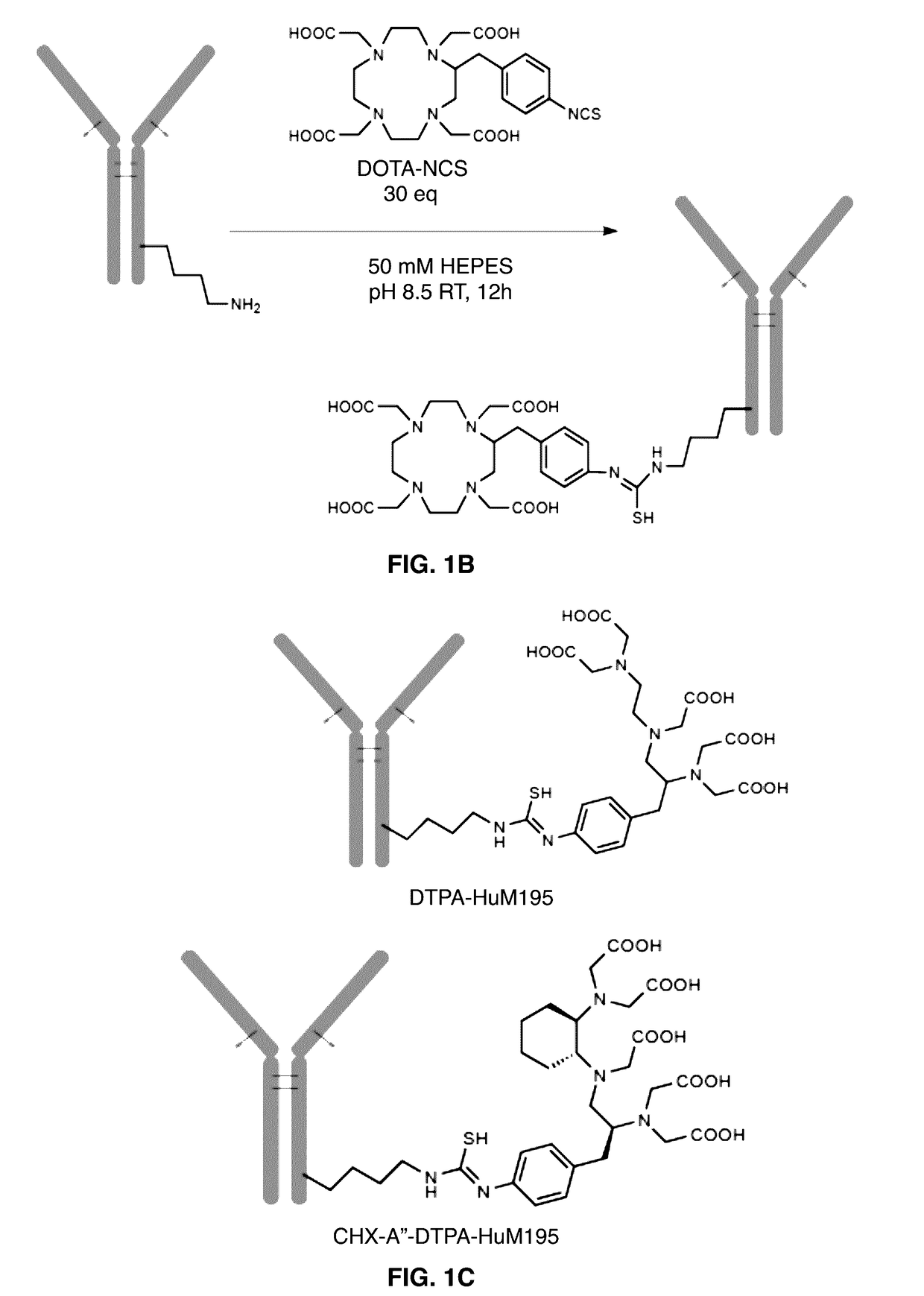One-Step Labeling of Antibodies to High Specific Activity with Actinium-225
a technology of actinium 225 and labeling strategy, which is applied in the field of radioimmunotherapy and chelation chemistry, can solve the problems of low specific activity, lack of cost-effective labeling strategy, and limited early work with sup>225/sup>ac, and achieve the effect of increasing the radiochemical yield of an actinium-225-chelant-biomolecule complex, high specific activity, and high specific activity
- Summary
- Abstract
- Description
- Claims
- Application Information
AI Technical Summary
Benefits of technology
Problems solved by technology
Method used
Image
Examples
example 1
Materials and Methods
Radionuclides, Reagents, and Monoclonal Antibodies
[0056]Actinium-225 was received from Oak Ridge National Laboratory as a nitrate residue, which was dissolved in 0.2M Optima grade HCl (Fisher Scientific) prior to use. Actinium-225 activity was measured using a CRC-15R radioisotope calibrator (Capintec, Inc) set at 775 and the displayed activity value was multiplied by 5. The parent Actinium-225 was measured when it was in secular equilibrium with its daughters, at least 6 hours and typically the next day after sample collection.
[0057]The chelating agent 1,4,7,10-tetraazacyclododecane-1,4,7,10-tetraacetic acid (DOTA) and the bifunctional ligands 2-(4-isothiocyanatobenzyl)-1,4,7,10-tetra azacyclododecane-1,4,7,10-tetraacetic acid, (p-SCN-Bn-DOTA); and 2-(4-isothiocyanatobenzyl)-diethylenetriaminepentaacetic acid, (p-SCN-Bn-DTPA) were obtained from Macrocyclics. The structures of the DOTA chelating agents and controls are shown in FIG. 1.
[0058]Chemicals used in the...
example 2
Formation of Antibody-Chelate Constructs
[0075]Constructs of antibodies attached to several different chelating moieties were generated using two attachment chemistries. These included “3-arm” DOTA constructs, in which one of the four carboxylic acids of DOTA is used to attach to antibody lysines via N-hydroxysuccinimide chemistry (FIG. 1A), and “4-arm” DOTA constructs in which a benzyl isothiocyanate group attaches to antibody lysines leaving all four carboxylic acids free (FIG. 1B). As controls, antibody constructs with DTPA, which previous reports indicated would not chelate 225AC at all4; and CHX-A″-DTPA, which was reported to chelate 225AC weakly during the labeling but release the metal upon serum challenge3, were generated (FIG. 1C). Antibodies were conjugated to two or more different substitution ratios, and constructs with about 10 DOTAs per antibody were used for future assays. Table 1 lists data on the conjugation of two representative antibodies, as well as abbreviated na...
example 3
Radiolabeling, Quality Control, and Stability In Vitro
[0076]3-arm and 4-arm constructs were radiolabeled using conditions shown in FIG. 2A. The kinetics of labeling were determined through periodic iTLC of aliquots of the reactions (FIG. 2B). Surprisingly, the 4-arm construct appeared to radiolabel more quickly than the 3-arm construct, with approximately 95% of the activity incorporated onto protein after 4 hours as compared to only 78% for the 3-arm construct. Both constructs labeled more slowly at room temperature than at 37 degrees. Constructs were radiolabeled for 2 hours for future studies. At this timepoint, 85% of the actinium was incorporated onto the 4-arm construct and 64% was incorporated onto the 3-arm construct for specific activities of approximately 0.18 and 0.14 Ci / g protein, respectively.
[0077]In a separate experiment, constructs were radiolabeled to a range of specific activities using a 2 hour procedure (Table 2). Radiochemical purity of the products was good to ...
PUM
| Property | Measurement | Unit |
|---|---|---|
| physiological temperature | aaaaa | aaaaa |
| temperatures | aaaaa | aaaaa |
| pH | aaaaa | aaaaa |
Abstract
Description
Claims
Application Information
 Login to View More
Login to View More - R&D
- Intellectual Property
- Life Sciences
- Materials
- Tech Scout
- Unparalleled Data Quality
- Higher Quality Content
- 60% Fewer Hallucinations
Browse by: Latest US Patents, China's latest patents, Technical Efficacy Thesaurus, Application Domain, Technology Topic, Popular Technical Reports.
© 2025 PatSnap. All rights reserved.Legal|Privacy policy|Modern Slavery Act Transparency Statement|Sitemap|About US| Contact US: help@patsnap.com



